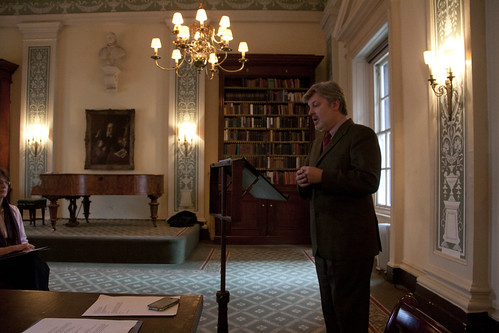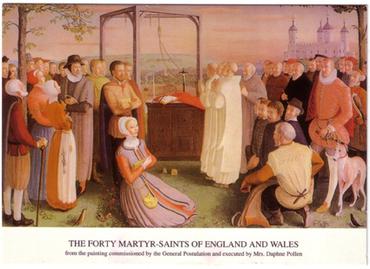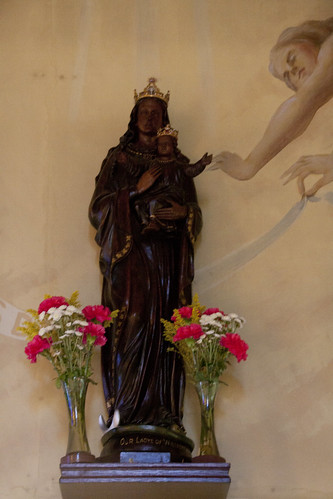I thought this article in Chisa (an Italian newspaper) was very interesting, in its report on a recent 'Study Day' on Sacred Music in Lecce, Italy, attended by some very eminent people, notably Cardinal Walter Brandmüller, president emeritus of the pontifical committee for historical sciences, and Monsignor Valentin Miserachs Grau, President of the Pontifical Institute of Sacred Music. The article summarizes under five headings the talk of the Maestro of a chant choir which is to perform before the Holy Father, Fulvio Rampi.
Rampi defined Chant with five traits, in his talk in Lecce:
1. Gregorian is the chant "proper" to the Latin liturgy. In it, the Church speaks its thought on the Word of God in song.
2. Gregorian is the "sonorous" expression of the interpretation that the Church makes of the Word.
3. Gregorian is not ornamentation, but is itself liturgy.
4. Gregorian is liturgy in its proper times and forms: from the introit to the gradual to the "communio," from the Kyrie to the Agnus Dei.
5. Gregorian is a whole that marks out and embraces the entire liturgical year, intelligible only in its unified vision, like the Sacred Scriptures. It is the musical form of the "lectio divina" of the Church.
Full article here.
23 May 2012
17 April 2012
Report on Weekend Chant course
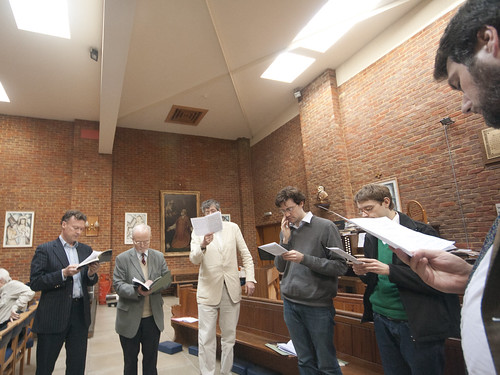
The Chant course was a great success this year. Nearly thiry singers took part, and were coached by Colin Mawby and Christopher Hodkinson (below).
The first Mass, on Friday evening, was accompanied by the Schola Abelis of Oxford; the remaining liturgies of the weekend were prepared for during the chant course.
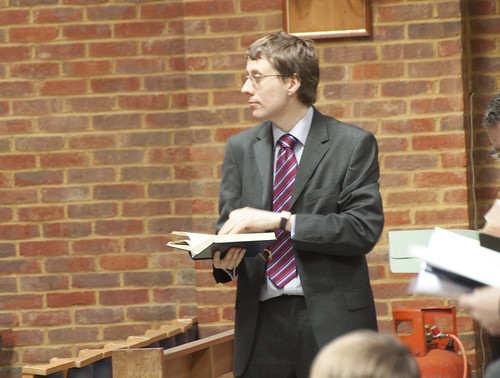
Chris Hodkinson got the more experienced group to do some wonderful faux bordon on Sunday with the Alleluia.
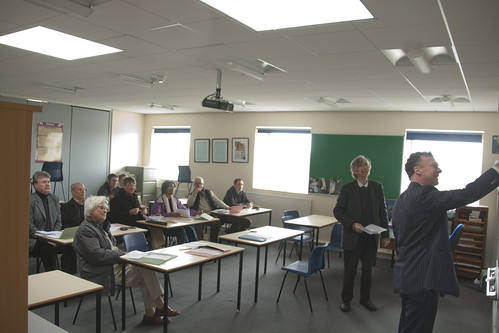
Colin Mawby (above), with the less experienced group.
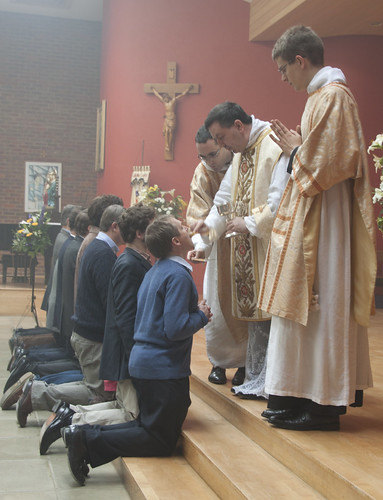
Singers receiving Communion before singing the Communion antiphon.
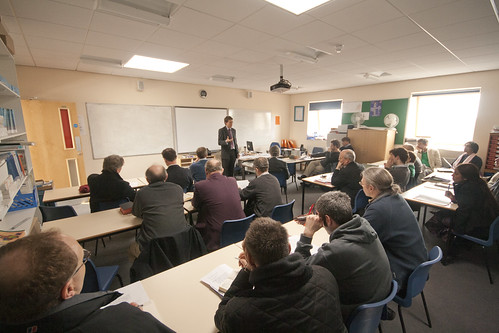
Chris Hodkinson gave a fascinating presentation on semiology to the whole group.
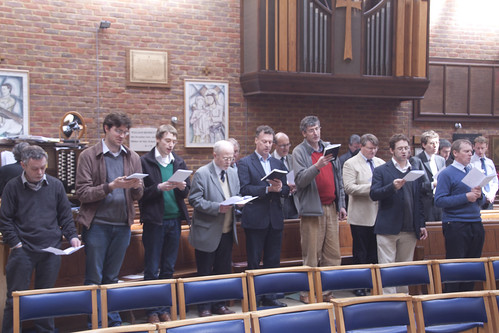
The singers at the final Mass on Sunday.
The combination of the Chant Course with a large retreat with the Traditioinal liturgy is a winning formula. Not only is there plenty of things to sing, but the inclusion of Vespers and Compline as well as Mass means there is a good range of difficulty in what is sung, including a significant amount of Psalmody, which is the basis of all Gregorian Chant. The presence of an appreciative congregation, and a large number of children, makes the whole thing more gratifying, and really more real, than it would otherwise be.
See here for a report on the Retreat; here for more photos.
03 April 2012
GCN Weekend Chant Course
Update: I'm putting this back at the top because this is the
LAST CALL FOR BOOKINGS!!
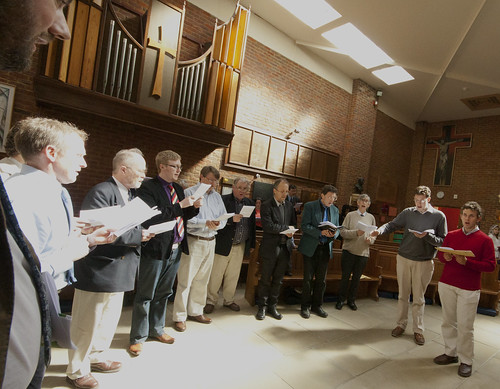
The Gregorian Chant Network's annual big chant course - a three-day intensive course (Friday afternoon/evening to Sunday morning) - will take place 13th to 15th April 2012. That is, Easter Friday to Low Sunday, the weekend after Easter itself, at the Oratory School, near Reading (map).
It will be led by Colin Mawby, the composer and former Director of Music at Westminster Cathedral, and Christopher Hodkinson, one of the Musical Directors of the Schola Gregoriana of Cambridge.
Each of them has an enormous experience of chant, its interpretation and performace, and having two chant teachers will enable participants to be divided for various purposes in the course of the weekend, enabling everyone to be taught in a way appropriate to their experience.
The course has always run alongside the St Catherine's Trust Family Retreat. Apart from seeing the vast number of small children devoted to the Church ancient liturgy, which is always fun, this means that participants in the chant course have the opportunity to sing at a succession of live liturgical events with an appreciative audience. Each of the three days has a Traditional Sung Mass, which have a special interest because it will be the week after Easter. There is also Compline on two days, and Vespers and Benediction on the Saturday.
The headline price is £90 all inclusive (tuition, accomodation and meals), and this falls dramatically for groups of singers from the same schola, if the schola is affiliated to the GCN. (And yes, of course you can affiliate right away at no cost, if you want to take advantage of this offer!). There is also a discount for LMS members, thanks to sponsorship from the Latin Mass Society. This means that it can be as cheap at £30 a person!
£90 per person
£50 each for 2 people from the same choir or schola
£40 each for 3 or more people from the same choir or schola
£10 discount for LMS members
The GCN's hope is that the course will be taken by enough members of a given group to make a difference to performance when they get home, and not just by an individual here and there. It is up to Chant Directors to make this happen!
Download an application form or email us: info@stcatherinestrust.org
LAST CALL FOR BOOKINGS!!

The Gregorian Chant Network's annual big chant course - a three-day intensive course (Friday afternoon/evening to Sunday morning) - will take place 13th to 15th April 2012. That is, Easter Friday to Low Sunday, the weekend after Easter itself, at the Oratory School, near Reading (map).
It will be led by Colin Mawby, the composer and former Director of Music at Westminster Cathedral, and Christopher Hodkinson, one of the Musical Directors of the Schola Gregoriana of Cambridge.
Each of them has an enormous experience of chant, its interpretation and performace, and having two chant teachers will enable participants to be divided for various purposes in the course of the weekend, enabling everyone to be taught in a way appropriate to their experience.
The course has always run alongside the St Catherine's Trust Family Retreat. Apart from seeing the vast number of small children devoted to the Church ancient liturgy, which is always fun, this means that participants in the chant course have the opportunity to sing at a succession of live liturgical events with an appreciative audience. Each of the three days has a Traditional Sung Mass, which have a special interest because it will be the week after Easter. There is also Compline on two days, and Vespers and Benediction on the Saturday.
The headline price is £90 all inclusive (tuition, accomodation and meals), and this falls dramatically for groups of singers from the same schola, if the schola is affiliated to the GCN. (And yes, of course you can affiliate right away at no cost, if you want to take advantage of this offer!). There is also a discount for LMS members, thanks to sponsorship from the Latin Mass Society. This means that it can be as cheap at £30 a person!
£90 per person
£50 each for 2 people from the same choir or schola
£40 each for 3 or more people from the same choir or schola
£10 discount for LMS members
The GCN's hope is that the course will be taken by enough members of a given group to make a difference to performance when they get home, and not just by an individual here and there. It is up to Chant Directors to make this happen!
Download an application form or email us: info@stcatherinestrust.org
22 February 2012
GCN Biennial meeting: report on our activities
 |
| Dr Joseph Shaw |
We have a new logo done for us - you can see it on the sidebar.
We've organised two weekend chant courses at the Oratory School; another will take place in April, led by Colin Mawby.
In collaboration with the Schola Gregoriana, there was a very successful series of chant training days in Portsmouth Cathedral, organised by our 'South' regional organiser, Neville MacMally.
Our London organiser, Matthew Schellhorn, has organised a chant day only a couple of weeks ago in Southwark Cathedral.
Training in Catholic cathedrals was one of the bright ideas we started the GCN with, and to be honest it has proved harder than I had hoped. Getting permissions together for such events requires more effort and coordination than in other venues, because more people are involved. However, we shall persevere, and I have recently met Bishop Davies of Shrewsbury who was enthusiastic about the idea for his own cathedral.
Something else I have done is the series of booklets of propers for diocesan feasts, which are now hosted on the LMS webstite, though the series is not yet complete.
Always eager to draw everyone with an interest in Chant together, I was delighted at the meeting to have representatives of the Ordinariate and the new Newman Institute, and even more pleased that they've agreed to be 'supporting organisations.'
I also drew attention to two important devopments: the establishment of the Ordinariate, and the publication of the new translation of the Missal. In both cases the forces of sanity in Church music are being given an extra opportunity. This isn't the end of the conflict, but it is certainly represents a more positive situation than before.
What we all need to continue to do, of course, is show the committment to excellence, and continual training of our singers, which alone will raise the standard of chant, attract more singers to it, and make it work as it should for the sanctification of souls.
21 February 2012
More 'supporting organisations' for the GCN
In the context of the Biennial meeting I can announce two more important organisations with a strong interest in Chant which have agreed to become 'supporters' of the Gregorian Chant Network:
The Ordinariate of Our Lady of Walsingham
The Blessed John Henry Newman Institute of Liturgical Music in Birmingham.
Both were represented at the meeting, the Institute by Fr Guy Nichols Cong Orat, its founder and Director, and the Ordinariate by the Rev Mr Daniel Lloyd, a deacon, who was one of the assistant clergy at Vespers.
They join our founding supporters:
The Latin Mass Society (which sponsors the GCN financially and administratively)
Una Voce Scotland
The Schola Gregoriana of Cambridge
The Association for Latin Liturgy
St Catherine's Trust.
We also have more choirs and scholas than ever affiliated to us - they now number over 30 - and we have 6 regional coordinators, working in the North West, the North East, London, the Midlands, the South, and Wales.
Furthermore, our meeting was attended by representatives from Una Voce France and the Irish affiliate of the Una Voce Federation, St Conleth's Catholic Heritage Association. UV France was represented by Henry de Villiers of the Schola St Cecile (and the New Liturgical Movement), and Philippe Nikolov of the Schola Reginae. The above photo of Fr Guy Nichols is from Henri's French blog post on the meeting.
Our aim is to be a forum for everyone involved in chant to be able to meet, discuss new initiatives, and give each other practical and moral support.
 |
| Ordinariate of Our Lady |
The Blessed John Henry Newman Institute of Liturgical Music in Birmingham.
Both were represented at the meeting, the Institute by Fr Guy Nichols Cong Orat, its founder and Director, and the Ordinariate by the Rev Mr Daniel Lloyd, a deacon, who was one of the assistant clergy at Vespers.
They join our founding supporters:
 |
| Fr Guy Nichols., Cong Orat |
The Latin Mass Society (which sponsors the GCN financially and administratively)
Una Voce Scotland
The Schola Gregoriana of Cambridge
The Association for Latin Liturgy
St Catherine's Trust.
We also have more choirs and scholas than ever affiliated to us - they now number over 30 - and we have 6 regional coordinators, working in the North West, the North East, London, the Midlands, the South, and Wales.
Furthermore, our meeting was attended by representatives from Una Voce France and the Irish affiliate of the Una Voce Federation, St Conleth's Catholic Heritage Association. UV France was represented by Henry de Villiers of the Schola St Cecile (and the New Liturgical Movement), and Philippe Nikolov of the Schola Reginae. The above photo of Fr Guy Nichols is from Henri's French blog post on the meeting.
Our aim is to be a forum for everyone involved in chant to be able to meet, discuss new initiatives, and give each other practical and moral support.
20 February 2012
GCN Biennial Meeting: Dr James MacMillan
07 February 2012
St Edmund of Canterbury in the 1962 Calendar
 |
| St Edmund of Canterbury |
There are two different Mass formularies, with their own chants, for him. The one used by most dioceses on 16th November (ie Birmingham, Clifton, Liverpool, Leeds, Middlesbrough, Northampton, Plymouth, Salford, Shrewsbury & Southwark) is simply the Common of Confessor Bishops, Statuit ei Domini. The other, used for the Translation in the places where it is celebrated (Brentwood, Portsmouth, and Old Hall), and in Westminster, Brentwood and Portsmouth for the feast, is taken entirely from the Feast of St Edmund in the Sarum Missal. It is unusual, and possibly unique, to see a complete adoption of a Sarum Mass formulary (set of propers) in modern books. In terms of chants the pieces can all be found in the Graduale Romanum, but the Introit and Alleluia have textual variants to include his name. The alleluia is the same as St Francis of Assisi, but with 'Hic Edmundi' instead of 'Francisci'. He is also described as 'modicus', 'modest', rather than (as with St Francis) 'humilis', humble. Perhaps this is becuase, unlike St Francis, St Edmund did not manage to resist elevation to high office in the Church.
Fitting 'Hic Edmundi' into the space where 'Fransisci' is a bit of a puzzle, and we are very grateful for the help of Colin Mawby here. Mr Mawby, who was Director of Music in Westminster Cathedral in 1960s, can remember singing it in Westminster many years ago. It is good to have this kind of knowledge passed on to future generations. His help has enabled me to add this Mass to our list of Diocesan feasts on the Latin Mass Society website.
A booklet with these chants can be downloaded from the LMS website here. You can see our whole page of diocesan feasts here:
http://www.lms.org.uk/resources/gregorian-chant/proper-chants-for-the-feasts-of-england-and-wales
13 January 2012
Chant Training Day in St George's Cathedral Southwark

(Updated: full schedule below.)
The London coordinator of the GCN is organising a Chant Training Day for Saturday 11th February, in Cathedral: the Catholic one, St George's Cathedral, Southwark. It will be led by the Cathedral's Director of Music, Nick Gale, and will follow a chant Mass in the Cathedral in honour of Our Lady of Lourdes: it is the anniversary (and the feast) of her apparition there. It will conclude with Vespers.
Mass is at 10.30 am; the chant training will begin at 11.15. Vespers will be at 4.30pm.
Singers will be divided for part of the day between more and less experienced groups, to enable everyone to get the most out of it.
Gregorian Chant Training Day with Nick Gale and Mark Johnson
(Gregorian Chant Network)
Schedule
11:45 Course begins, registration, plenary session with Nick Gale
13:00 Lunch (bring packed lunch)
13:45 Chant Course afternoon sessions (Nick Gale and Mark Johnson)
15:30 Break 15:45 Rehearsal for Vespers
16:30 First Vespers of Septuagesima Sunday
17:00 Ends
Fee: £15; reduced to £10 for LMS members.
To register interest for the Gregorian Chant Training Day please email
lmssouthwarknorth AT gmail DOT com
Contact (replace AT with @ and DOT with .)
06 January 2012
A Mass for St Hildelitha and St Cuthberga
 St Hildelitha and St Cuthberga are wonderful examples of the extraordinary religious women produced by the Anglo-Saxons, along with St Hilda of Whitby and St Ethelberga of Ely. St Hildelitha founded a convent at Barking, which St Cuthberga joined; St Cuthberga later founded a 'double monastery' (of monks and nuns, on the same site but with separate enclosures) at Wimbourne and led a group of nuns on St Boniface's German mission. They are celebrated together, in the 1962 Calendar, in Brentwood diocese on 3rd September. Here's a stained glasss window showing St Cuthberga.
St Hildelitha and St Cuthberga are wonderful examples of the extraordinary religious women produced by the Anglo-Saxons, along with St Hilda of Whitby and St Ethelberga of Ely. St Hildelitha founded a convent at Barking, which St Cuthberga joined; St Cuthberga later founded a 'double monastery' (of monks and nuns, on the same site but with separate enclosures) at Wimbourne and led a group of nuns on St Boniface's German mission. They are celebrated together, in the 1962 Calendar, in Brentwood diocese on 3rd September. Here's a stained glasss window showing St Cuthberga.Their Mass is 'Virgines laudent nomen Domini', a Mass for 'All Virgins' (ie not only martyrs) which in 1914 was for some reason restricted to 'Certain places': that is, it stopped being used for saints in the Universal Calendar. This means that it is not to be found in the Liber Usualis; it is still in the Graduale Romanum, however, which has a section at the back for Commons used in Masses for Certain Places, and I have assembled a booklet from the Graduale scanned by the Church Music Association of America. Here they are.
http://www.lms.org.uk/resources/gregorian-chant/chant_proper_booklets/chants_for_hildelitha_and_cuthberga
The chants are ancient, but only in Brentwood Diocese on 3rd September, if you are lucky enough to be able to attend a Sung Mass in the Extraordinary Form, are you likely to hear them in a liturgical setting, at least in England and Wales.
This concludes my series of English and Welsh feasts for the time being. All of these chants, and a couple more, are to be found on the LMS website here.
03 January 2012
Bl Richard Whiting and Bl John Beche in the 1962 Missal

 Another set of Chant Propers for feasts celebrated in specific dioceses in England and Wales, to be found in the same supplement for the English Benedictine Congregation where I found the Mass of the English Martyrs, is a set for the Benedictine martyrs. Richard Whiting was the Abbot of Glastonbury; Hugh Farringdon the Abbot of Reading Abbey, John Beche the Abbot of St Werburgh Abbey, Chester. These three great men were martyred by King Henry VIII. The Benedictines celebrated their feast, and that of 'four other Benedictine monks, martyrs', on December 1st.
Another set of Chant Propers for feasts celebrated in specific dioceses in England and Wales, to be found in the same supplement for the English Benedictine Congregation where I found the Mass of the English Martyrs, is a set for the Benedictine martyrs. Richard Whiting was the Abbot of Glastonbury; Hugh Farringdon the Abbot of Reading Abbey, John Beche the Abbot of St Werburgh Abbey, Chester. These three great men were martyred by King Henry VIII. The Benedictines celebrated their feast, and that of 'four other Benedictine monks, martyrs', on December 1st.On the same day, various dioceses throughout England celebrated martyrs special to themselves. In Birmingham it is the Martyrs of Oxford University, in Nottingham St Ralph Sherwin, in Northhampton and Portsmouth it is St Edmund Campion and Companions. As far as chants go, these feasts all use one of the standard Masses for Martyrs, 'Intret in conspectu'. In Westminster, however, they celebrate Bl. Hugh Farringdon & Companions, and in Brentwood Bl John Beche, using the same Mass as the Benedictines: 'Vineam de Aegypto'.
I have created a booklet of these chants, and you can download them here.
http://www.lms.org.uk/resources/gregorian-chant/chant_proper_booklets/proper_chants_for_whiting_and_beche
Pictures: Blessed Hugh Farringdon on the left, and Bl John Beche on the right.
31 December 2011
St Helen, Empress, in the 1962 Missal
As I noted in an earlier post, I have seen the propers for feasts for the whole of England and Wales pasted into the back of old Libers, but I have never seen the chants for feasts specific to particular dioceses, or groups of dioceses. I was delighted to discover, then, that one of these, St Helen, Empress (18th August) is included in the supplement for the United
States of America, which is included in the on-liber Liber Usualis scanned by the Church Music Association of America. I have uploaded a booklet of these chants to the LMS website; they can be downloaded as a pdf here:
http://www.lms.org.uk/resources/gregorian-chant/chant_proper_booklets/st_helen
 The
feast of St Helen is a 3rd Class feast in Liverpool and Salford, and St Helen is the co-titular of Brentwood Cathedral, so it is
celebrated in that Cathedral as well (First Class). St Helen, the finder of the True Cross and mother of the Emperor Constantine, was, of course, said to be a British princess. Britain played an important part in her son's life, since he was proclaimed Emperor at York; he went on to vindicate his claims in the ensuing civil war, and make Christianity the official religion of the Roman Empire. Evelyn Waugh's historical novel 'Helena' is a thoroughly enjoyable re-telling of St Helen's legend.
The
feast of St Helen is a 3rd Class feast in Liverpool and Salford, and St Helen is the co-titular of Brentwood Cathedral, so it is
celebrated in that Cathedral as well (First Class). St Helen, the finder of the True Cross and mother of the Emperor Constantine, was, of course, said to be a British princess. Britain played an important part in her son's life, since he was proclaimed Emperor at York; he went on to vindicate his claims in the ensuing civil war, and make Christianity the official religion of the Roman Empire. Evelyn Waugh's historical novel 'Helena' is a thoroughly enjoyable re-telling of St Helen's legend.
If anyone has information about other diocesan feasts, or the chant settings of any other diocesan feasts, please let me know! I am anxious to find
Bl Adrian Fortescue (Birmingham diocese, 11th July)
Our Lady in Porticu (Cardiff and Menevia, 17th July)
Bl Hugh More (Nottingham, 1st September)
St Hilda (Westminster, Birmingham, Clifton, Northhampton, Nottingham, 17th November).
Others I have found I will publish in due course.
http://www.lms.org.uk/resources/gregorian-chant/chant_proper_booklets/st_helen
 The
feast of St Helen is a 3rd Class feast in Liverpool and Salford, and St Helen is the co-titular of Brentwood Cathedral, so it is
celebrated in that Cathedral as well (First Class). St Helen, the finder of the True Cross and mother of the Emperor Constantine, was, of course, said to be a British princess. Britain played an important part in her son's life, since he was proclaimed Emperor at York; he went on to vindicate his claims in the ensuing civil war, and make Christianity the official religion of the Roman Empire. Evelyn Waugh's historical novel 'Helena' is a thoroughly enjoyable re-telling of St Helen's legend.
The
feast of St Helen is a 3rd Class feast in Liverpool and Salford, and St Helen is the co-titular of Brentwood Cathedral, so it is
celebrated in that Cathedral as well (First Class). St Helen, the finder of the True Cross and mother of the Emperor Constantine, was, of course, said to be a British princess. Britain played an important part in her son's life, since he was proclaimed Emperor at York; he went on to vindicate his claims in the ensuing civil war, and make Christianity the official religion of the Roman Empire. Evelyn Waugh's historical novel 'Helena' is a thoroughly enjoyable re-telling of St Helen's legend.If anyone has information about other diocesan feasts, or the chant settings of any other diocesan feasts, please let me know! I am anxious to find
Bl Adrian Fortescue (Birmingham diocese, 11th July)
Our Lady in Porticu (Cardiff and Menevia, 17th July)
Bl Hugh More (Nottingham, 1st September)
St Hilda (Westminster, Birmingham, Clifton, Northhampton, Nottingham, 17th November).
Others I have found I will publish in due course.
29 December 2011
Propers of National and Diocesan Feasts in the 1962 Missal
I have spent some time recently researching feasts proper to England and Wales in the 1962 Missal. There are feasts proper to the whole of England and Wales: nine, to be exact, including St George (April 23rd) and the Martyrs of England and Wales (May 4th). There are also, listed conveniently in the Baronius Press hand missal, pages and pages of feasts not in the Unversal Calendar of the Latin West, and not celebrated in the whole of England and Wales, but still celebrated in certain dioceses in England and Wales.
These feasts become problematic when they have special texts composed for them. The texts themselves are not difficult to find - diocesan supplements for the altar missals exist, and they are all there in the Baronius Press missal - but when the text need to be sung, one needs to have the chant setting. And these do not seem to be widely available, if at all.
Of the feasts of the whole of England and Wales, a full 'missa propria' was composed for 'BB Joannis Fischer et Thomae Morus': that is, Bishop John Fisher and Thomas More, when they were beatified in 1886; the feast was originally celebrated on 4th May. This Mass, 'Deus venerunt gentes', stayed on 4th May when SS Fisher & More were canonised and moved to July 9th (getting a new Mass formulary), and 4th May became the feast of the Blessed Martyrs of England and Wales. I have found it in the English Benedictine supplement included in a 1908 Schwann Graduale and a later Solesmes Graduale, both of which I have been able to scan. It is a 3rd Class feast.
Here is the Introit being sung by the Schola Abelis of Oxford; there are more videos of the propers of this Mass here.
As a service to readers I have uploaded a booklet of these propers to the Latin Mass Society website, and you can download them here:
http://www.lms.org.uk/resources/gregorian-chant/chant_proper_booklets/proper_chants_for_4th_may
Bishop Fisher and Thomas More were canonised in 1935, and I have found their new Mass pasted into the back of an old Liber Usualis I own, with an Imprimatur dated 1936. Even more conveniently, it is to be found in the Graduale Romanum's appendix 'Masses for Certain Places', including the Gradual scanned by the Church Music Association of America. Here is this Mass:
http://www.lms.org.uk/resources/gregorian-chant/chant_proper_booklets/chants_for_ss_fisher_and_more
All sorts of things can be found pasted into the back of old Libers, or loose within its pages: St Joan of Arc, St Joseph the Workman, and other things obviously added to the calendar since the date of the printing of that particular Liber. Clearly these little booklets were made available when the Mass texts and melodies were published. What I have never seen, however, in an official supplement or pasted in somewhere, are the proper chants for diocesan feasts, in cases where these are not simply borrowed from other feasts and commons. I shall be posting about some of these later.
These feasts become problematic when they have special texts composed for them. The texts themselves are not difficult to find - diocesan supplements for the altar missals exist, and they are all there in the Baronius Press missal - but when the text need to be sung, one needs to have the chant setting. And these do not seem to be widely available, if at all.
Of the feasts of the whole of England and Wales, a full 'missa propria' was composed for 'BB Joannis Fischer et Thomae Morus': that is, Bishop John Fisher and Thomas More, when they were beatified in 1886; the feast was originally celebrated on 4th May. This Mass, 'Deus venerunt gentes', stayed on 4th May when SS Fisher & More were canonised and moved to July 9th (getting a new Mass formulary), and 4th May became the feast of the Blessed Martyrs of England and Wales. I have found it in the English Benedictine supplement included in a 1908 Schwann Graduale and a later Solesmes Graduale, both of which I have been able to scan. It is a 3rd Class feast.
Here is the Introit being sung by the Schola Abelis of Oxford; there are more videos of the propers of this Mass here.
As a service to readers I have uploaded a booklet of these propers to the Latin Mass Society website, and you can download them here:
http://www.lms.org.uk/resources/gregorian-chant/chant_proper_booklets/proper_chants_for_4th_may
Bishop Fisher and Thomas More were canonised in 1935, and I have found their new Mass pasted into the back of an old Liber Usualis I own, with an Imprimatur dated 1936. Even more conveniently, it is to be found in the Graduale Romanum's appendix 'Masses for Certain Places', including the Gradual scanned by the Church Music Association of America. Here is this Mass:
http://www.lms.org.uk/resources/gregorian-chant/chant_proper_booklets/chants_for_ss_fisher_and_more
All sorts of things can be found pasted into the back of old Libers, or loose within its pages: St Joan of Arc, St Joseph the Workman, and other things obviously added to the calendar since the date of the printing of that particular Liber. Clearly these little booklets were made available when the Mass texts and melodies were published. What I have never seen, however, in an official supplement or pasted in somewhere, are the proper chants for diocesan feasts, in cases where these are not simply borrowed from other feasts and commons. I shall be posting about some of these later.
19 December 2011
Second Biennial Meeting of the Gregorian Chant Network
 Nearly two years ago, on January 30th 2010, the GCN was launched at a meeting at the London Oratory, attended by representatives of about two dozen chant scholas and a number of people involved in singing or teaching the chant. We agreed at that time to have such a meeting every two years.
Nearly two years ago, on January 30th 2010, the GCN was launched at a meeting at the London Oratory, attended by representatives of about two dozen chant scholas and a number of people involved in singing or teaching the chant. We agreed at that time to have such a meeting every two years.The launch meeting was widely reported and was addressed by Colin Mawby, the distinguished composer and former Director of Music at Westminster Cathedral.
 The next meeting is now well in preparation, and will take place on Saturday, 18th February 2012, at the London Oratory (the St Wilfrid Hall and the Little Oratory). It will be addressed by James MacMillan, another Catholic composer deeply concerned about, and practically involved in, chant. The Apostolic Nuncio, Archbishop Mennini, will join us and lead Vespers in the Little Oratory.
The next meeting is now well in preparation, and will take place on Saturday, 18th February 2012, at the London Oratory (the St Wilfrid Hall and the Little Oratory). It will be addressed by James MacMillan, another Catholic composer deeply concerned about, and practically involved in, chant. The Apostolic Nuncio, Archbishop Mennini, will join us and lead Vespers in the Little Oratory.The meeting is an internal meeting of the GCN and as such it is invitation only. The directors of all our affiliated choirs and scholas are automatically invited, as are representatives from our 'supporter' organisations: the Latin Mass Society, the Association for Latin Liturgy, the Schola Gregoriana, Una Voce Scotland, and the St Catherine's Trust. Others involved with the chant have been invited as before. Anyone with a Catholic choir or schola can naturally get an invitation by affiliating.
For those who have received invitations, don't forget to reply!
17 December 2011
Introducinng the Juventutem London Schola
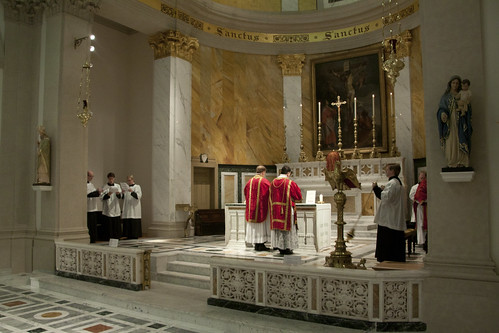 |
| The Juventutem London Schola, in the sanctuary at St Patrick's Soho Square. |
One of the features of the group is a particular love of Solemn Mass, ie Mass with celebrant, deacon and subdeacon. It should always be remembered that, although Missa Cantata and and Low Mass are indispensible elements in parish life, it is Solemn Mass which is the normative form of Mass, giving it the full honour which is its due. Solemn Mass in the Extraordinary Form is extraordinarily beautiful, with many ceremonies which are cut down, or omitted, in Missa Cantata. Obviously a choir is necessary for Solemn Mass, and after some experimentation and development (including a couple of Masses accompanied by the Schola Abelis, who had travelled from Oxford for the occasion), the London Juventutem group has now established a schola of its own, which even has a blog.
 |
| Polyphonists at the LMS Pilgrimage to Aylesford, with the Juventutem London Schola. |
Its director is Matthew Schellhorn, a professional pianist and the Latin Mass Society Representative for Southwark North. The Juventuetem Masses are monthly, on the last Saturday of each month, and alternative months are sung with polyphony. The core of the choir is however a small chant schola, led by Matthew and drawn from the young congregation. They can also on occasion sing elsewhere, and did so at the LMS Pilgrimage to Aylesford. They have joined the GCN and have been added to the list of affiliates and the map.
 |
| The chant schola singing during communion at Aylesford (at the back of the photo). |
Get in touch with them by email: juventutemlondonschola@gmail.com
16 December 2011
New roving Schola for the South East: Anglorum Chorus
One of their first Masses was for the Latin Mass Society Annual Pilgrimage to Willesden on 29th October. They have also sung for the Ordinariate of Our Lady of Walsingham.
The schola has joined the GCN and been added to our list of affiliates and the map. You can use this email address to contact them: anglorum.chorus@gmail.com.
Subscribe to:
Posts (Atom)
